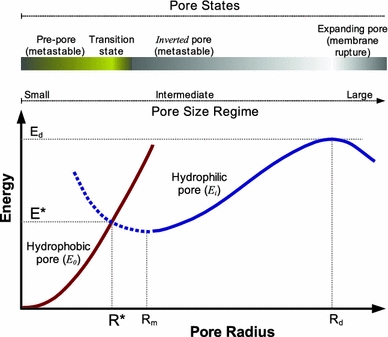Fig. 3.

Free energy of hydrophobic (pre-pore) and hydrophilic pores as a function of pore radius. The graph is a qualitative representation based on the continuum theory described by Glaser et al. (1988) for reversible electrical breakdown. Initial pores (pre-pores) are postulated to be of hydrophobic type (Fig. 1b). At a critical pore radius R*, the energy of these pores equals that of a hydrophilic pore (Fig. 1d), formed by reorientation of some lipids to line the pore wall with their head-groups. Then, the energy at that state (E*) corresponds to a hypothetical nucleation barrier for lipid rearrangement to form a hydrophilic pore. This latter starts with an undefined energy (dashed line), but as the radius increases the energy of the pore can be assumed to follow Litster’s theory (Litster 1975; Taupin et al. 1975). At larger pore size, a second critical value is predicted (R d), beyond which the membrane would irreversibly break
